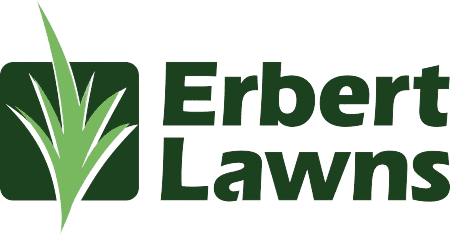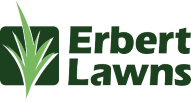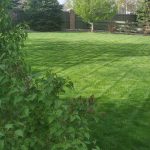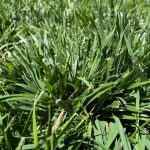What is Best for Your Lawn?
Dethatching and liquid aeration are two methods used to improve the health of lawns. This opens the debate for dethatching vs. liquid aeration, which is better? It would really depend on what is happening in your lawn. Dethatching is meant to help if you have a large thatch build up, where liquid aeration is meant to help the soil compaction.
Some Causes of Thatch Buildup:
- Kentucky Bluegrass (which is one of the most common grasses in Colorado) can have stem issues, which can lead to thatch buildup.
- Infrequent mowing, which causes more than ⅓ of the blade to be cut (it’s recommended to only cut ⅓ of the blade per cut) meaning longer grass clippings.
- Dead leaves or other decaying elements
Problems Thatch Causes:
A build up of thatch can be harmful for the lawn because it will act as a barrier between the roots of the grass and the soil. This makes it difficult for the lawn to access sunlight, oxygen, water and nutrients. This will cause issues in the soil and the quality of roots.
Liquid aeration
…is the process of spraying a soil-loosening compound, such as nitrogen or potassium, into the soil to soften and loosen compacted soils.
Liquid Aeration Methods:
Garden Hose: You can attach a liquid aeration solution to your hose and then apply the product using the hose.
Tank Hose: This is used typically for commercial use. A truck with a large tank will have the liquid aeration solution mixed in and will use a hose that is attached to the tank to apply the product.
Benefits of Liquid Aeration
This process is especially beneficial for lawns that are compacted due to heavy foot traffic, or lawns with shallow roots. Liquid aeration helps to improve soil drainage, promote deeper root growth, and allow for better nutrient absorption. It also helps to reduce the need for dethatching, which can be a labor-intensive and costly process.
Liquid aeration offers a safer and more cost-effective alternative to dethatching. It is much less disruptive to the soil microbial activity, and it can be done quickly and easily. It also helps to reduce compaction, promote deeper root growth, and improve soil drainage. Overall, liquid aeration is a great choice for lawns that are prone to compaction and shallow rooting.
Disadvantages of Liquid Aeration:
If you have a lot of thatch in your lawn, liquid aeration may not be as useful for the lawn. This is used more when you are trying to loosen up the soil, not when you are trying to eliminate a thick layer of thatch.
When To Use Liquid Aeration:
Liquid aeration is generally best done during the growing season of your lawn. With the clay soils in Colorado, it is recommended to aerate your lawn both in spring and fall.
This method is best used when your soil is compacted. You can test this out in two different ways, one is sticking a long stick about 3 inches into the soil. If you have a difficult time doing this, you may want to aerate. You can also cut a cross section in the lawn to see how deep the roots are growing. You will want to cut down at least 6 inches, if you see roots that are less than 6 inches, it may be time to aerate.
How Liquid Aeration Works:
Dethatching
…is done by raking up excess thatch. There are a few ways this can be done.
Dethatching Methods:
Manual Dethatcher: This is a rake with small curved blades that will cut into the thatch layer and allow you to pull it up.
Electric Dethatcher: This has a rotating wire and is used similar to a mower to help pull up the thatch.
Power Rake: This is a machine with sharp tines that is also similar to a mower, you push this across the lawn to pull up the thatch.
*You want to be careful when using this method because this can tear up the root system in the lawn.
Benefits of Dethatching
Dethatching is beneficial for a lawn that has a thick build up. You can test this by digging up a wedge of lawn down to the soil, to see exactly how thick the layer is. If you have a thick build up then dethatching would be helpful. When dethatching a lawn this will help with overall health of the lawn as well as the roots. Dethatching will help the roots access nutrients and sunlight better. It helps remove the barrier that the roots tend to have if there is a thick thatch layer.
Disadvantages of Dethatching
However, there are some issues with dethatching. Dethatching can cause damage to the lawn if done incorrectly, as it can cause the removal of vital nutrients and organic matter. Additionally, dethatching can disrupt the natural microbial activity in the soil, which can lead to an imbalance in the soil’s pH levels. Furthermore, dethatching can be expensive and time-consuming, as it requires specialized equipment and multiple passes to be effective.
When To Use Dethatching
You will want to dethatch a lawn during the growing season. You want to avoid doing this when the lawn is dormant or stressed. Dethatching is only needed when you have a substantial amount of thatch.
This method is used when there is a layer of thatch that is a half inch or more. The thatch layer is usually a brown layer that feels slightly spongy to the touch. You can test how thick your thatch is by using a stick of your finger. You will want to stick them in and see how deep the layer is, if it is over half an inch, you may want to dethatch.
Dethatching vs. Liquid Aeration Answer:
…for the great debate. Dethatching vs. liquid aeration, which should you choose? Liquid aeration is a more efficient, less disruptive, and more cost effective way of aerating lawns than dethatching. It requires no machinery and is applied through the use of a special liquid formula that penetrates the soil and encourages the growth of beneficial microbes and fungi. It loosens soil, reduces compaction, and allows for better water and nutrient absorption. Since it does not involve the use of a machine, it is less disruptive to the lawn and can be done any time of the year. Additionally, liquid aeration is less expensive than dethatching and can be used on a variety of soils.
Erbert Lawns can help with your liquid aeration. Please call or text us today, if you would like more information 303-948-6631.

Kelsey Keller
Business Manager
With six years of experience in lawn care, Kelsey Keller has learned the
many facets of what it takes to make lawn green and weed free. She pays close attention to
what customers need and what will make their lawn happy. She continues to learn and discover
what the turfs in Colorado need to be able to thrive.










